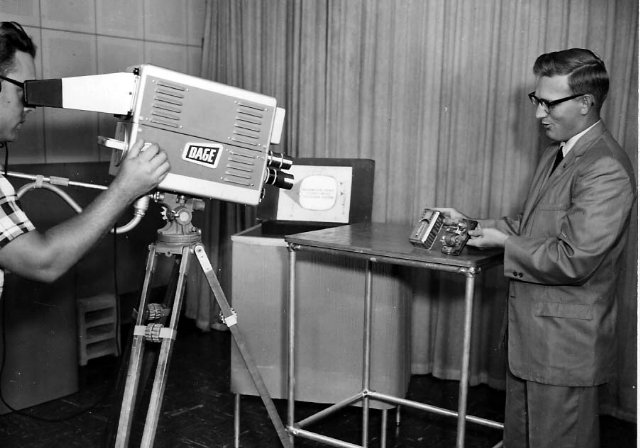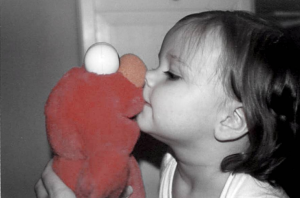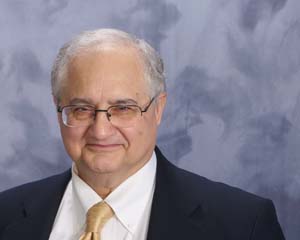Introduction to Distance Education: Educational Television
By Dr. Farhad (Fred) Saba, Ph.D.
Founder, Distance-Educator.com
In 1945 Iowa State University applied to the Federal Communication Commission (FCC) for an educational television (ETV) license and after five years started broadcasting programs making the University the first ETV broadcaster in the country in 1950 (Saettler, 1990). Jim Finn a pioneer in the field of educational technology conducted one of the first studies on educational television in 1953. Finn’s study was followed by a number of research projects that provided a rich array of results about educational television. Kumata (1960) summarized the results of research conducted on educational television in the late 1950’s. His comprehensive review of data-based research literature clearly indicated the importance of learner traits in learning from television. These studies were pursued at a time that media research in the US was primarily interested in media attributes, such as size of the screen, effectiveness of color, placement of captions and other similar low-level variables. Attention to media attributes in this period was in part a continuation of the media studies that were conducted in various branches of the US armed services during and after World War II to ascertain the effectiveness of mediated instruction at a time that instructors were not readily available to provide critically needed training.

Image from Washington County , Maryland Closed Circuit Television Report, 1963
Kumata (1960) listed the following learner traits as “prime” factors in learning from instructional television, and not “in the fact of TV transmission.” In summary, these were:
- Audience Motivation. “Superiority of TV is reported more often in voluntary audience situations than in captive audience situations.”
- Subject matter preparation and integration into a teaching process.
- Audience Intelligence. “TV seems to affect intelligence levels differently but exactly how has not been shown.”
- The mode of presentation. “TV or face-to-face has no differential effect upon retention of the subject matter.”
- Interaction with teacher.“…gives students reassurance and greater willingness to undergo the television experience.”
- Attitude toward TV and toward subject matter. Negative attitude towards the medium has no effect on learning achievements; however, it might affect selection and future use of television for learning.
- Adult Learners. Popularity of educational television among adult learners indicates that “adult credit courses such as those offered in Chicago may carry the educational television station” as a viable financial enterprise.
…if learner traits are paired with the right treatment attributes (mediated or otherwise), instruction could lead to the control and prediction of learning outcomes.
These relatively early findings are remarkable in light of what media researchers showed during the next two decades. Researchers, including Salomon and Snow (1970); Snow and Salomon, (1968); Salomon (1969, 1971); Cronbach and Snow (1977); Snow, Federico, and Montague, (1980) conducted a series of studies based on the idea that if learner traits are paired with the right treatment attributes (mediated or otherwise), instruction could lead to the control and prediction of learning outcomes. Aptitude-treatment interaction (ATI) clarified several issues related to cognition and mediated instruction. It also revealed the potentially unlimited combinations of cognitive states with media variables, thus defying parsimony and closure in explaining the impact of media on learning. In 1985 Clark and Salomon presented a comprehensive review of research in media and teaching and called this phenomenon “confounding variables.”Snow summarized the strengths and weaknesses of ATI research in the following as quoted in Kearsley (1994).
1. Aptitude treatment interactions are very common in education.
2. Many ATI combinations are complex and difficult to demonstrate clearly, and
3. No particular ATI effect is sufficiently understood to be the basis of instructional practice.
These ATI studies provide the background for understanding the complexity of learning at a distance as they will be discussed later in this series.
In 1967, Chu and Schramm, researchers at Stanford University, examined 207 studies involving 421 separate comparisons of ETV and conventional classroom instruction.
- In 308 observations (73% of the studies) they found no statistically significant difference in learning achievement.
- 63 studies (15%) reported television instruction to be superior, and
- 50 studies (12%) reported conventional education to be better.Wilbur Schramm did a follow up study in 1975, that included analysis of achievement data on students in primary, secondary, and post-secondary education, in different subject matters. His analysis showed while there were no statistically significant difference among subject matters taught, younger children learned more from television than older ones (Wetzel, Radtke, and Stern 1994). Since the rapid expansion of instructional television in the 1950s and the ascendance of social science research after the Second World War, comparing distance education with the so-called face-to-face education has been a favorite subject of education researchers. In the 1960s, Wilbur Schramm conducted studies comparing instructional television (ITV) with classroom instruction. Also, Schramm (1962) summarized the results of more than 400 “scientifically designed and statistically treated comparisons of ITV and classroom teaching” (p. 66). He concluded:“we can say confidently that students learn from it, and that they learn fast and efficiently” (p. 66). Furthermore, “the conclusion has been ‘no significant difference’ between learning from television, and from classroom teaching” (p. 66).
After Chu and Schramm arrived at this conclusion many other researchers have compared classroom instruction to distance education. Wetzel, Radtke, and Stern (1994) scientists at the Naval Personnel Research and Training Center, then located in in San Diego, California, summarized the results of comparative studies until the mid 1990s. Their summary, among other important findings undated that there was no statistically significant difference between learning via educational media and face-to-dace instruction. Amore recent example is a study conducted by Johnson, Aragon, Shaik, and Palma-Rivas (2000). Researchers in this study compared learning outcomes of an online course with a similar course taught face-to-face. The study concluded “there was no difference between the two course formats in several measures of learning outcomes” (Johnson et al., 2000, p. 29). Invariably, comparative studies of distance education and classroom instruction show “no statistically significant difference.” Another recent meta-analysis of 19 studies out of an original pool of 700, which met the carefully selected criteria of authors, Machtmes and Asher (2000) confirmed previous conclusions that “there does not appear to be a difference in achievement between distance and traditional learners” (p. 43).
Early researchers also studied the attitude of students and teachers towards television. Both faculty and students showed a more favorable attitude towards teaching and learning via television, once they had experience in teaching a course via TV, or taking a course on TV. In general, students preferred to be in a conventional classroom, but favored a TV course, if the classroom was a large lecture hall. Among students, according to Wetzel, Radtke, and Stern (1994) “relevant factors are the extent of personal contact with the instructor and quality of instruction.”
 In the 1960s the Civil Rights movement and other social developments brought to light the plight of the children living in inner cities who were deprived of adequate means of learning. These social concerns lead to the establishment of the Public Broadcasting Service (PBS) and the Corporation for Public Broadcasting (CPB). The task of the CPB was to fund production and broadcast of educational programs. Perhaps the best known and the most successful program funded by CPB is Sesame Street which reached millions of pre-school children throughout the country on the PBS network of stations throughout the country and offered young children the type of early education language development and mathematical thinking that otherwise they would not have received.
In the 1960s the Civil Rights movement and other social developments brought to light the plight of the children living in inner cities who were deprived of adequate means of learning. These social concerns lead to the establishment of the Public Broadcasting Service (PBS) and the Corporation for Public Broadcasting (CPB). The task of the CPB was to fund production and broadcast of educational programs. Perhaps the best known and the most successful program funded by CPB is Sesame Street which reached millions of pre-school children throughout the country on the PBS network of stations throughout the country and offered young children the type of early education language development and mathematical thinking that otherwise they would not have received.
By early 1970’s there was considerable evidence that the medium of communication is not as much of a factor in distance teaching and learning as the quality of instruction, and provision for two-way synchronous, or asynchronous communication between students and instructors. Sesame Street, for example, was a carefully designed and produced educational television program. It also remains to be the most widely evaluated television program ever. Evaluation results indicated that youngsters exposed to Sesame Street had a clear advantage in learning elementary reading, writing, math, and social skills over those who were not exposed to the program, or had less exposure to it. However, this advantage could be enhanced if teachers or parents augmented the viewing session with providing learners advanced organizers prior to viewing and a equation and answer period, or a discussion group after such viewing had taken place.
Educational television was further extended to schools and institutions of higher education in the 1970s and throughout the 1980s by the rapid expansion of cable television and increased use of telecommunication satellites in broadcasting. Business and industry also made extensive use of telecommunication satellites for training purposes as it became possible to originate television programs from the campuses of major corporations and beam them to specific locations throughout the world. Auto manufacturers, insurance companies, banks, electronic manufacturers and computer companies used video broadcasting via the satellite for corporate communication, as well as for training their sales force, engineering staff and other employees.
As the National Science Foundation (NSF) provided access for universities to the Internet in the mid 1990s, educators gained a powerful means for teaching and learning that was radically different from previous electronic media. Arrival of networked computing to higher education, the place of work, K-12 schools, and even homes did not come a moment too soon. Since towards the late 1980s, and in early 1990’s families, institutions, societies, and relations among nations were going through rapid change. Novel solutions were required to meet the demands of the changing social institutions.
REFERENCES
Chu, G. C, and W. Schramm. 1967. Learning From Television: What the Research Says. Washington: National Association of Educational Broadcasters.
Clark, R. E., & Salomon, G. (1985). Media in teaching. In M. Wittich ( Ed.). The handbook of research on teaching. Washington, DC: American Educational Research Association.
Cronbach, L. & Snow, R. (1977). Aptitudes and Instructional Methods: A Handbook for Research on Interactions. New York: Irvington.
Johnson, S. D., Aragon, S. R., Shaik, N., and Palma-Rivas, N. (2000). Comparative analysis of learner satisfaction and learning outcomes in online and face-to-face learning environments. Journal of Interactive Learning Research, 11(1), 29 – 49.
Kumata, H. (1960). A decade of teaching by television. In Schramm, W. (Ed,). The impact of television: Selected studies form the research sponsored by the National Educational Television and Radio Center. Urbana, Ill. University of Illinois Press.
Saettler, P. (1990). The evolution of American educational technology. Englewood, CO: Libraries unlimited.
Salomon, G. (1971). Heuristic models for the generation of aptitude-treatment interaction hypotheses. Jerusalem, Israel: Hebrew University of Jerusalem. (ERIC Reference No.: ED 059589).
Salomon, G., & Snow, R. E. (1968). The specification of film attributes for psychological and educational research purposes. Stanford, CA: Stanford Center for Research and Development in Teaching. (ERIC Reference No.: ED 021 465).
Salomon, G., & Snow, R. E. (1970). Commentaries on research in instructional media: An examination of conceptual schemes. Bloomington, IN: Indiana University. (ERIC Reference No.: ED 044 900).
Salomon, G., (1969). What does it do to Johnny?: A cognitive -functionalistic view of research on media. (ERIC Reference No.: ED 034 734).
Schramm, W. (1962). What we know about learning from instructional television. In Educational Television: The next ten years. Stanford CA: The Institute for Communication Research, Stanford University.
Snow, R. E., & Salomon, G., (1968). Aptitudes and instructional media. Audio Visual Communications Review (16), 4, 341-357.
Snow, R., Federico, P., & Montague, W. (1980). Aptitude, Learning, and Instruction, Vols 1 & 2. Hillsdale, NJ: Erlbaum.
Wetzel, C. D., Radtke, P. H., Stern, H. W. (1994). Instructional effectiveness of video media. Hillsdale: N. J. Lawrence Earlbaum Associates, Publishers.








